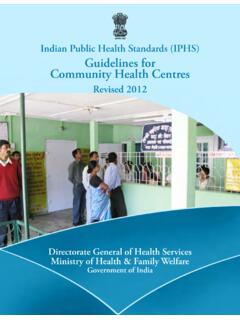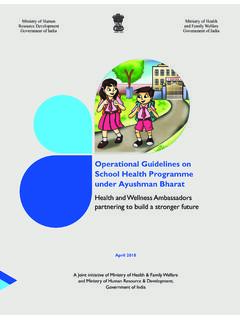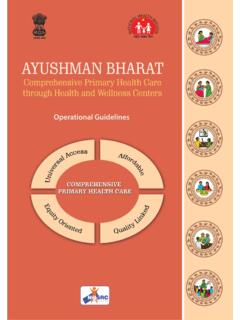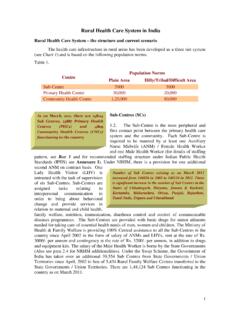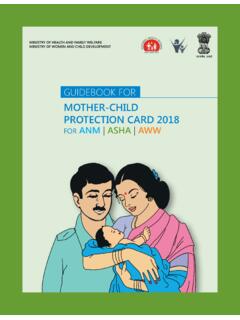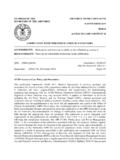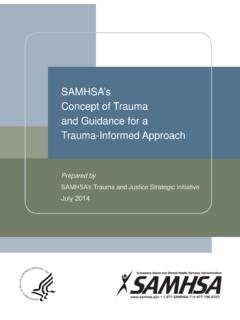Transcription of Indian Public Health Standards (IPHS) Guidelines for Sub ...
1 Indian Public Health Standards (IPHS). Guidelines for Sub-Centres Revised 2012. Directorate General of Health Services Ministry of Health & Family Welfare Government of India Indian Public Health Standards (Iphs). Guidelines for Sub-Centres Revised 2012. Directorate General of Health Services Ministry of Health & Family Welfare Government of India Contents Message v Foreword vi Preface vii Acknowledgements viii Executive Summary 1. Indian Public Health Standards for Sub-Centres 3. 3. Objectives of the Indian Public Health Standards for 3. Categorization of 4. Services to be Provided in a 6. 15. Physical Infrastructure.
2 15. Furniture .. 16. 16. Drugs .. 17. Support Services .. 17. Waste Disposal .. 17. Record Maintenance and Reporting .. 17. Monitoring 17. Quality Assurance and 18. Annexures Annexure 1: National Immunization Schedule for Infants, Children and Pregnant Women .. 19. Annexure 2: Job Functions of Health Worker Female/ANM, Staff Nurse, Health Worker Male 21. Annexure 3: Layout of Sub-Centre .. 34. Annexure 4: List of Furniture, Other Fittings and Sundry Articles .. 37. Annexure 5: Equipment and 38. Annexure 5A: Newborn Corner in Labour 42. Annexure 6: Suggested List of Drugs .. 44. Annexure 7: Standards for Deep Burial Pit; Bio-Medical Waste (Management and Handling).
3 Rules, 1998 46. Annexure 8: Records and 47. Annexure 8A: Registers .. 47. Annexure 8B: IDSP 48. Annexure 9: Checklist .. 50. Annexure 9A: A simpler checklist that can be used by non-governmental organization/Panchayati Raj Institutions/Self Help Groups 52. Annexure 10: Proforma for Facility Survey of Sub-Centres on IPHS .. 54. Annexure 11: Model Citizen's Charter for 60. Annexure 12: List of 61. References 63. List of Members of the Task Force Constituted for Revision of IPHS Documents 64. iv Indian Public Health Standards (IPHS) Guidelines for Sub-Centres MESSAGE. National Rural Health Mission (NRHM) was launched to strengthen the Rural Public Health System and has since met many hopes and expectations.
4 The Mission seeks to provide effective Health care to the rural populace throughout the country with special focus on the States and Union Territories (UTs), which have weak Public Health indicators and/or weak infrastructure. Towards this end, the Indian Public Health Standards (IPHS) for Sub-centres, Primary Health Centres (PHCs), Community Health Centres ( chcs ), Sub-District and District Hospitals were published in January/February, 2007 and have been used as the reference point for Public Health care infrastructure planning and up-gradation in the States and UTs. IPHS are a set of uniform Standards envisaged to improve the quality of Health care delivery in the country.
5 The IPHS documents have been revised keeping in view the changing protocols of the existing programmes and introduction of new programmes especially for Non-Communicable Diseases. Flexibility is allowed to suit the diverse needs of the states and regions. Our country has a large number of Public Health institutions in rural areas from Sub-centres at the most peripheral level to the district hospitals at the district level. It is highly desirable that they should be fully functional and deliver quality care. I strongly believe that these IPHS Guidelines will act as the main driver for continuous improvement in quality and serve as the bench mark for assessing the functional status of Health facilities.
6 I call upon all States and UTs to adopt these IPHS Guidelines for strengthening the Public Health Care Institutions and put in their best efforts to achieve high quality of Health care for our people across the country. New Delhi (Ghulam Nabi Azad). Foreword The National Rural Health Mission (NRHM) launched by the Hon'ble Prime Minister of India on 12 April 2005, aims to restructure the delivery mechanism for Health to providing universal access to equitable, affordable and quality Health care responsive to the people's needs. The implementation framework of NRHM, envisaged that the Public Health institutions including Sub-centres would be upgraded from its present level to a level of a set of Standards called Indian Public Health Standards (IPHS).
7 IPHS for Sub-Centers (SCs), Primary Health Centers (PHCs), Community Health Centers ( chcs ) and hospitals were developed and last released in January/February, 2007 and have since been used as the reference point for Public Health care infrastructure planning and up gradation in the States and Union Territories (UTs). Sub-Centre is the most peripheral and first contact point between the primary Health care system and the community. Therefore the success of any nationwide program depends largely on the well functioning Sub-centres providing services of acceptable Standards to the people. As setting Standards is a dynamic process, need was felt to update the IPHS keeping in view the changing protocols of existing National Health Programmes, introduction of new programmes especially for Non-Communicable Diseases and prevailing epidemiological situation in the country.
8 The IPHS for Sub-centres has been revised by a task force comprising of various stakeholders under the Chairmanship of Director General of Health Services. Subject experts, NGOs, State representatives and Health workers working in the Health facilities have also been consulted at different stages of revision. The newly revised IPHS for SC has considered the services, infrastructure, manpower, equipment and drugs in two categories of Essential (minimum assured services) and Desirable (the ideal level services which the states and UTs shall try to achieve). Sub-centres have been categorized into two categories depending upon the prevailing epidemiological situation and resources available in different parts of the country.
9 This has been done to ensure optimal utilization of resources. States and UTs are expected to categorize the Sub-centres and provide infrastructure according to the laid down Guidelines in this document. I would like to acknowledge the efforts put by the Directorate General of Health Services in preparing the Guidelines . It is hoped that this document will be useful to all the stakeholders. Comments and suggestions for further improvements are most welcome. ( ). Preface The Sub-centres are vital peripheral institutions for providing primary Health care to the people and play an important role in the implementation of various Health & Family Welfare programmes at the grass-root level.
10 One of the important components of National Rural Health Mission (NRHM) is to strengthen the Sub-centres to the level of Indian Public Health Standards (IPHS), which were first prescribed in early 2007. The aim of the IPHS is to provide quality services which are of optimum level, fair and responsive to the client's needs, provided equitably and which deliver improvement in the Health and wellbeing of the population (Effective). In addition, services should be affordable (Economical) and have inherent element of accountability. A task force was constituted in early 2010 to review the existing IPHS, remove mismatch if any, between services and infrastructure provided, incorporate new programmes and protocols in line with the changing requirements of the country taking into consideration the minimum functional level needed for providing a set of assured services.
